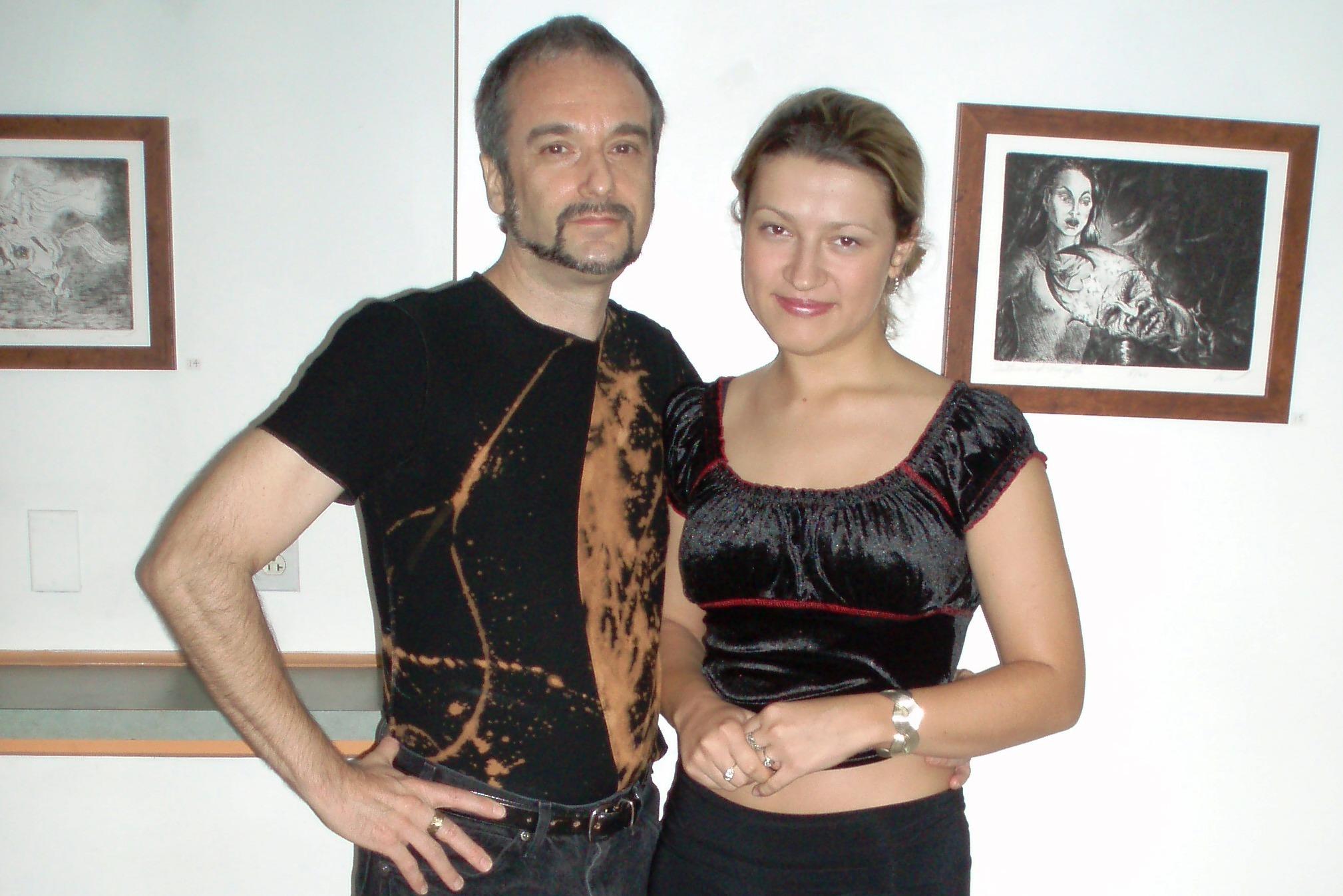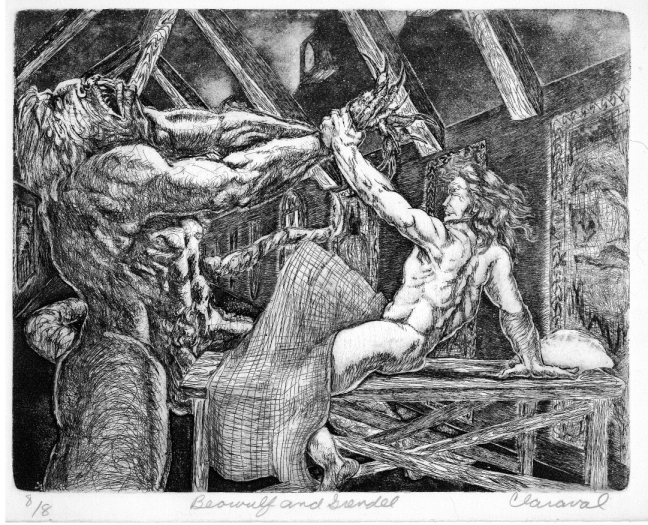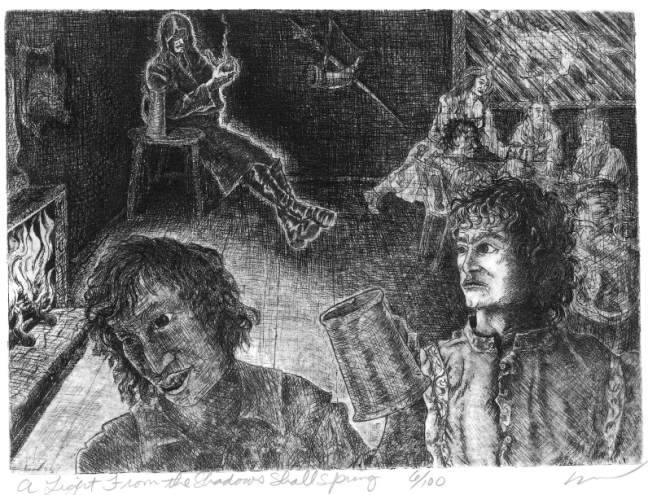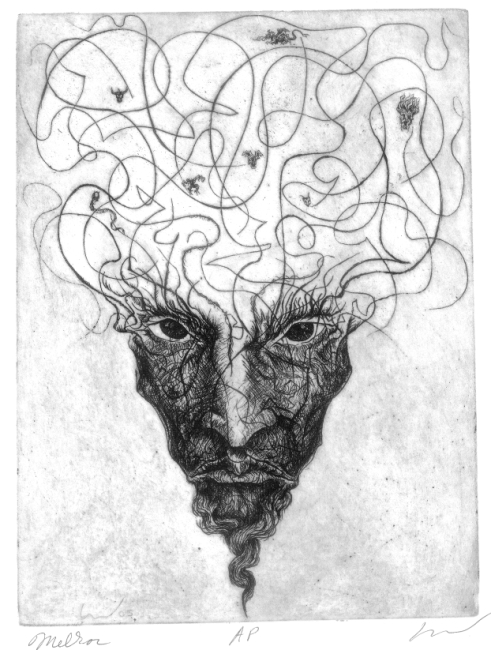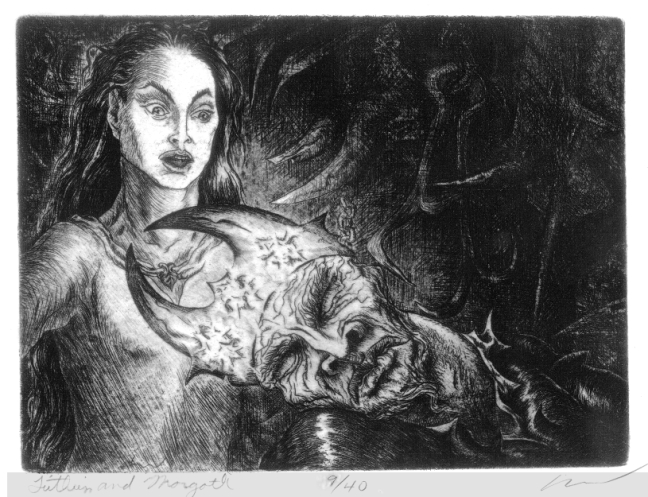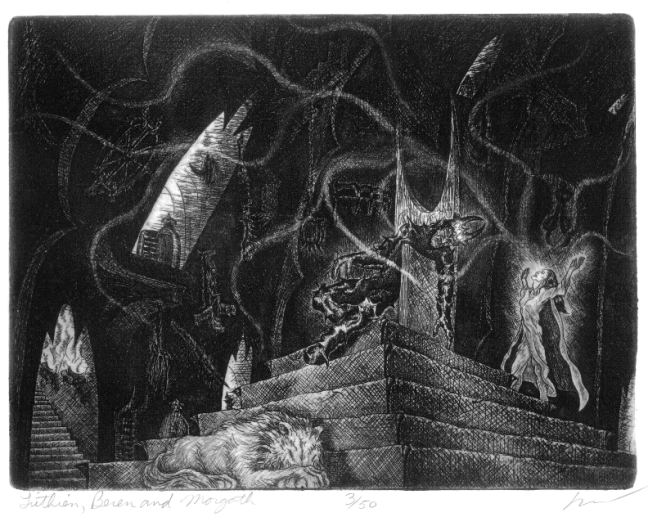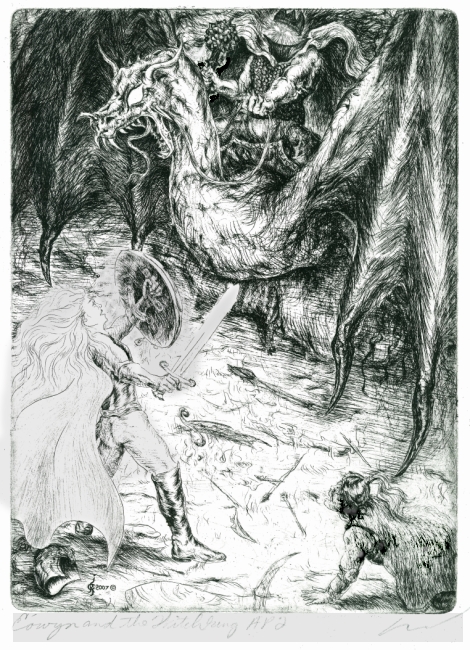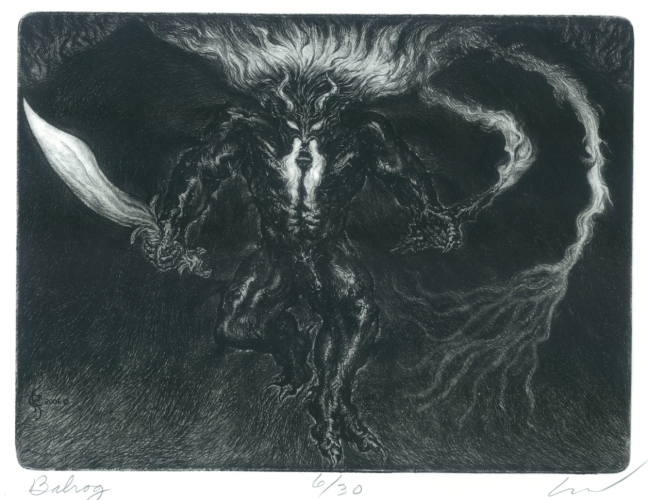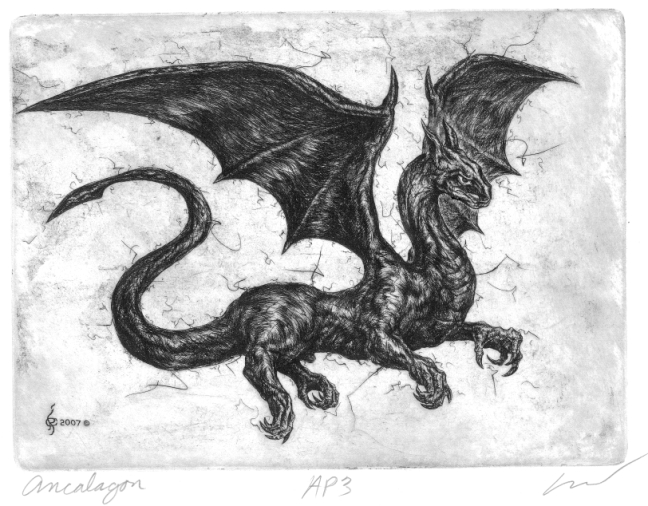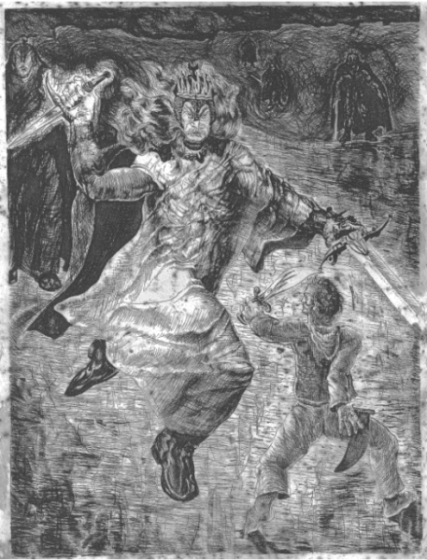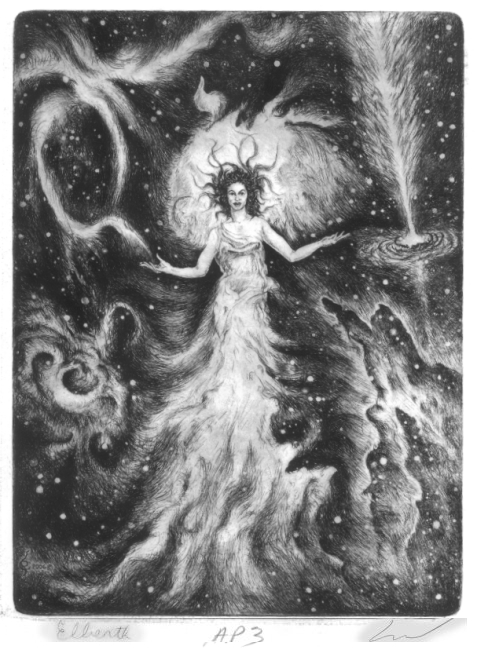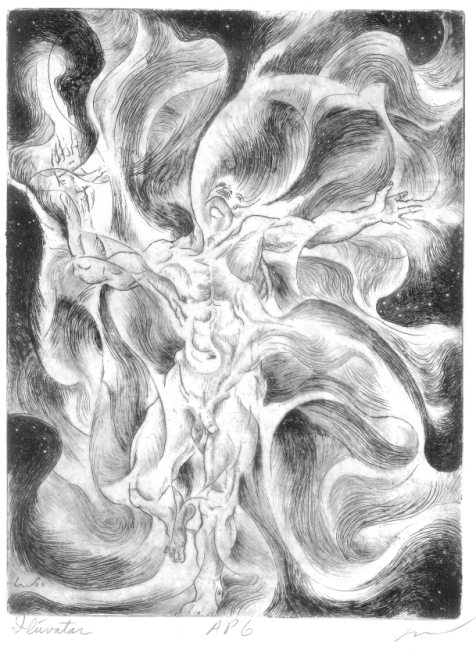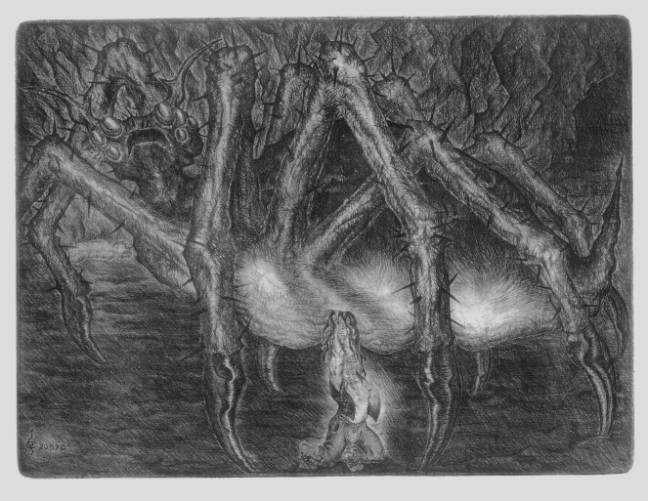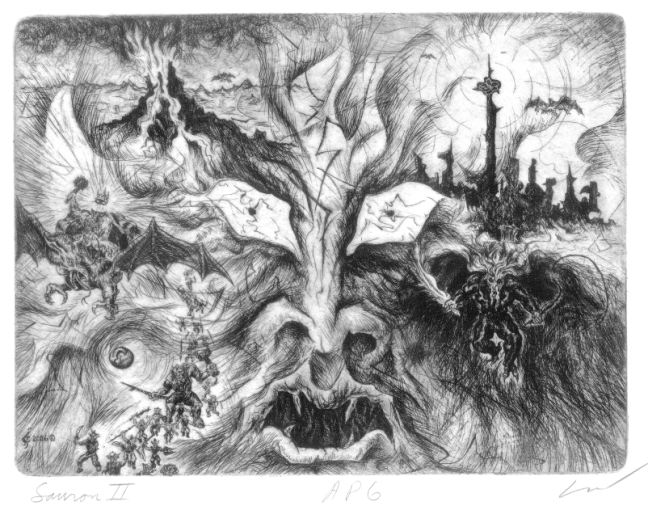Interview with Tolkien artist Richard Claraval (20.10.07 by Pieter Collier) - Comments
Interview with Tolkien artist Richard Claraval
Here follows an interview with the artist, followed by some extra etchings.
Q: Can you tell us a little about yourself?
I grew up in a small town near Pittsburgh, Pennsylvania. As a young kid I drew from an early age, but was probably more interested in sports than art. I 'm both a tennis and table tennis player. This early, and continuing interest in sports has informed my art, as I am have a strong passion for the human figure in motion. I got a degree in art from Indiana University of Pennsylvania, focusing on drawing, printmaking and sculpture.
During my first printmaking course in 1972 I knew I wanted to do a series of etchings based on tolkien's, "The Lord of the Rings". As a college sophomore I had already read this masterpiece about three or four times in fewer years. The imagery was, and still is to me the most vivid, and inspiring of anything I've ever read. Although many other art projects have occupied my time in the years since, I have never completely abandoned this idea. The release of Peter Jackson's films brought this project again to the front of my mind, and I decided it was finally time to do it.
Q: When did you discover that you could draw?
I had some confidence in my abilities as a draftsman in high school, when I drew a lot of comic book heroes. Really though, it was in college, when I first drew the human figure from life, that I new for certain that I had some talent.
Q: What first interested you in Professor tolkien's works?
The fabulous tale he created in the Lord of the Rings was the first thing that drew me to Professor Tolkien. For me it has the feeling of having always existed, somewhere, and Tolkien opened a door and let it come into our world. It has a sense of being so perfect, so right, and it is so astonishingly detailed.
Scott Laird, a great friend of mine who had been a tennis rival, introduced me to The Lord of the Rings shortly after high school, in 1970.
Q: I'd like to talk about your art. What media do you work in?
My medium is traditional copper plate etching. I do both the etching of the plate, and the printing myself.
Just in case some of your visitors are unfamiliar with etchings, I hope you don't mind if I give a short explanation of the process. Briefly, the artist, using a metal scriber, draws through an acid proof ground made of wax that has been thinly spread over a metal plate (usually copper or zinc). The plate is placed in a container filled with acid that incises the metal wherever the artist has drawn. The plate is then covered with ink, and its surface wiped clean, leaving ink only in the lines. Dampened paper is placed on the plate, and all three run through an etching press. The paper is forced into the incised lines absorbing the ink, and the print, also called an etching, is produced. For a more detailed explanation of the etching process and an explanation of limited editions, please see my web site: tolkienetchings.com.
I greatly enjoy the spontaneity of line one can achieve in etching due to the fact that that the etching ground offers very little resistance, and also that you never have to stop to sharpen a pencil or refill a pen. Also the depth and subtleties of blacks that can be achieved in this medium are unrivaled, and relate well to the powerful conflicts of light and dark Tolkien frequently uses.
Q: Did you ever think about (or are you already) selling full-sized reproductions of this and the other drawings?
Well I really don't need to be concerned with making reproductions. With etchings, as many as 200 of the same image can be printed from a single plate, and each of these is considered an original work of art. This is the great thing about prints; because they are done as multiples their price is consequently much lower than one-of-a-kind art, such as drawings or paintings, and therefore affordable to a wider range of people. All my Tolkien Etchings are just $100 unframed.
Also, because my goal is to create a limited edition fine art book of them when I have produced around 50, they are all the same size 9 x 12 inches, approximately 22.5 x 30 centimeters. Right now I'm looking for a grant for this project, as the cost and time involved for me to do it on my own are out of my range.
Also, I've lately been thinking that I would very much like to do some large graphite drawings based on Professor tolkien's work. For these I would definitely be interested in reproduction.
Q: What was your inspiration for "A Light From the Shadows Shall Spring"?
Trying to show Strider in the shadow, but with a bit of light around him was what I was after here. I'm also a huge fan of Rembrandt's etchings, and this is my most overt attempt to emulate him -- even a couple of the background figures where stolen from him.
Q: What was your inspiration for "Melkor"?
The swirling lines, where his cranium would normally be, are an attempt to give a visual representation to Melkor's convoluted thinking of resentment and hatred.
Eventually this caused him to degenerate, and become completely evil, and spawned all Middle Earth's monsters: dragons, werewolves, balrogs, orcs, and etcetera. Though difficult to see, some of these are represented, very tiny, among the swirling lines.
Q. You are drawing scenes from The Silmarillion and The Lord of the Rings. What works inspires you most?
Definitely The Lord of the Rings. Although I enjoy the magical feeling of the more ancient tales, and will definitely do many more images from them, the more highly realized and detailed images in the LOTR are more compelling to me. Also, the way the very powerful scenes flow out of the much more delineated narrative, and the way they are created with such gorgeous and powerful language, draws me more to them.
Q. Your " Luthien, Beren and Morgoth " and " Balrog " are two very wonderful etches, still they are also very controversial. Are you not afraid to depict such powerful scenes and heavily discussed creatures like the Balrog?
Eowyn confronting the Witch King, Gandalf battling the Balrog, these, and the other most powerful images, where the parts of the book that most inspired me. Shying away from them was the exact opposite of my inclination. I wanted to do them immediately.
Also, what I am attempting to do in my Tolkien Etchings is to, as honestly and accurately as possible, portray the images I see in my mind when I read his works.
An artist does not have to be a Tolkien scholar, and know every version of a scene or character, to give an honest, accurate interpretation.
Q. In your drawings I can see many influences yet it is difficult to place it all. I see old Greek art, tolkien's own art, Medieval art, even the Peter Jackson movies... What are your inspirational sources? It seems a good mixture of a lot of sources?
When I was a kid it was Marvel comic books, and their most famous illustrator, Jack "King" Kirby. Though he took liberties with anatomy, I loved the tremendous dynamism of his figures. Then about age 12, I saw the movie, "The Agony and the Ecstasy", which was the first time I had ever seen Michelangelo's work, and he blew the top of my head right off.
It 's Rembrandt, though, your countryman, and the first, perhaps greatest proponent of etching, who is the biggest influence on my etchings. I actually keep a book that contains reproductions of all his etchings in their actual size, near me when I am working. I try to refer to it as little as possible, but at times it is very helpful to see how a genius handled some element.
Abstract expressionism, though this may seem very removed from illustration, is something I am very enamored of. At times I've incorporated some spontaneous, agitated lines in some of my etchings, and intend to do this more in the future.
Discovering Picasso's Volard Suite in college had a big effect on me. I'm also a big fan of Blake, Goya, and Odellion Redon, who although he wasn't an etcher, did litho's and drawings that relate strongly.
I did study Greek art in school, and have generally been a student of the human figure my whole artistic life; it's what I know and do the best. I think you can see a bit of that from the sculptures on my web site.
Both my style, and my visions of The Lord of the Rings developed decades before the movies, starting in 1972, so they did not affect me very much. However, Peter Jackson and his team have provided such a huge wealth of detail of such things as clothing, weapons armor, landscapes, etcetera, etcetera, that I will no doubt refer to, and adapt bits of it in future etchings.
Q: Why did you do your Tolkien related drawings in black and White?
The powerful chiaroscuro possible with line etchings, I have always thought, since 35 years ago, has the potential to show the depth of seriousness and intensity of Tolkien, that other mediums, although they certainly have this potential too, less specifically facilitate.
Also, black just suits my rather high-strung nature. When I was about 8 years old or so I greatly enjoyed the Zorro movies and TV show -- loved his black silhouette flashing across the rooftops. Once my mother asked me what my favorite color was, and I emphatically replied, black!
Q: What is unique about your art? What makes it different from that of other artists who find their inspiration in Tolkien and The Lord of the Rings?
Besides the fact that I am exclusively using black and white etchings, I think the high level of intensity of much of my work, and that it is so strongly focused on the drama of Tolkien, makes it somewhat unique. As I say in my artist statement on my web site, ".my focus is perhaps somewhat narrower than some other illustrators of Tolkien. The exact representation of architecture, or landscape, or styles of clothing, etcetera doesn't excite me. What I'm interested in is capturing the emotional essence of the powerful, and beautiful images tolkien's words conjure in my mind -- whether the subject is human drama, or the drama of a place, or an idea." This is not to say I that I am only interested in the darker side, I have been working on some lighter images as well, such as Goldberry entertaining the Hobbits, and Frodo in Hobbiton.
Of course, this is, also, not to say that mine is the only work that is dramatic. Obviously many Tolkien artists have done very dramatic, intense stuff.
Q: What is your favorite piece of art?
My favorite piece of art, in any medium, is Beethoven's ninth symphony. The "Ode to Joy", succeeds in it's purpose more than any other work of art of which I am aware.
In visual art it's a lot tougher to say. The two people that impress me most are Michelangelo and Jackson Pollack, but none of their pieces stands alone for me. I guess if I had to chose just one, I'd pick the Sistine Ceiling.
Q: Who is your favorite Tolkien related artist and why?
John Howe is my favorite. Though I like both Ted Nasmith and Allan Lee a lot, as well as Angus Mcbride. Howe's ability with both the human figure and various monsters in dynamic action, and in creating beautiful landscapes and architecture, separates him in my mind. His "Death of Smaug", is a particular favorite. The circular composition is very dynamic and tightly integrated, and it has lots of lovely subtleties. It is a great picture.
Q: Where do you draw?
I live in an artists' loft and work in my studio, which is in my apartment. Occasionally I sketch, and take photos for source information in local parks.
Q: When you're not working, what are your favorite ways to relax and have fun?
I frequently go to art openings, and I play in a Table Tennis league throughout the winter, occasionally going to tournaments.
Q: One final question. What do you think about the Hobbit movie?
The one thing I can say for certain is that I cannot imagine any actor creating a better Gandalf than Ian McKellen did in The Lord of the Rings. He was absolutely brilliant, bringing out many of the myriad aspects and subtleties, of he who I think is tolkien's greatest character. I greatly hope he is in the prequel. His presence alone would make the Hobbit worth seeing. Also, I've heard that relations between Peter Jackson and New Line are improving, which is encouraging.
Spread the news about this J.R.R. Tolkien article:
